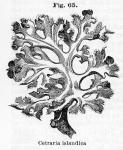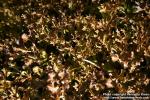
 Preparation: Decoction of Cetraria
Preparation: Decoction of Cetraria
The lichen, "Cetraria islandica (Linné) Acharius"—(U. S. P.). (Lichen islandicus, Linné).
Class: Lichenes.
COMMON NAMES:Iceland moss, Iceland lichen.
Botanical Source.—Iceland moss is a perennial, foliaceous plant, from 2 to 4 inches high; the thallus is erect, tufted, olive-brown, paler on one side, laciniated, channeled, and dentato-ciliate, the fertile lacinae being very broad. The shields are brow oppressed, and flat, with an elevated border (L.)
History.—This lichen is a native of the mountainous section of Britain and the northern countries of Europe, particularly Iceland. It is found as far south as France, Italy, Switzerland, and Spain, growing in mountainous elevations. It is likewise found in the antarctic countries, British America, and in the United States from the eastern states to the mountains of Carolina and westward to the Rocky Mountains, from Colorado northward. In northern Europe it has long been used for food under the name mosi, mus, or mossa (Pharmacographia). Though called Iceland moss, none is exported from that island. It is diversified in color, being brownish or grayish-white on some parts, and of a reddish hue in others; it is without odor, with a mucilaginous, bitter, somewhat astringent taste, and when dry the lichen is crisp, cartilaginous, and coriaceous, and is convertible into grayish-white powder. It swells up in water, absorbing more than its own weight of that fluid, communicating a portion of its bitterness to it, as well as a little mucilage. When long chewed it is converted into a mucilaginous pulp, and when boiled in water the decoction becomes a firm jelly on cooling.
Description.—The following article is required by the Pharmacopoeia: "From 5 to 10 Cm. (2 to 4 inches) long, foliaceous, irregularly branched into fringed and channelled lobes, brownish above, whitish beneath, and marked with small, depressed spots; brittle and inodorous; when softened in water, cartilaginous, and having a slight odor; its taste is mucilaginous and bitter. It should be freed from pine leaves, mosses, and other lichens, which are frequently found mixed with it"—(U. S. P.).
Chemical Composition.—Iceland moss consists of starchy lignin, a peculiar starch, gum, uncrystallizable sugar, a substance closely related to chlorophyll, wax, various salts, and a bitter principle called cetrarin or cetraric acid (C18H16O8), which it is said, has been used in Italy for cinchona. Christison states that it may be obtained pure "by boiling the coarsely-powdered lichen in 4 times its weight of rectified alcohol, filtering the solution when tepid, acidulating it with diluted hydrochloric acid, diluting it with 3 times its volume of water, and purifying the crystals which slowly form, by squeezing them and washing them with a little ether." As thus obtained, cetrarin is in white, microscopic, acicular crystals, permanent, odorless, intensely bitter, insoluble in water, sparingly so in cold alcohol, more so in boiling alcohol, or ether, and readily soluble in alkaline solutions. When its alkaline solutions are treated with acids, the cetrarin is procured without being changed in its properties; concentrated hydrochloric acid converts it into a blue coloring matter. It is said to prove an efficient febrifuge in 2 or 3 grain doses, administered every 2 or 3 hours. Iceland moss also contains licheno-stearic acid (C14H34O3), fumaric acid (lichenic acid of Pfaff [1826]), oxalic and tartaric acids, and thallochlor (of Knop and Schnedermann), a chlorophyll unaffected by chlorhydric acid. The most important part of Iceland moss is its nutritive principle, to which the name of lichenin or lichen-starch has been given, and which exists to the extent of 70 percent. It maybe obtained by macerating the chopped lichen for 24 hours in 18 parts of water, containing 1/250 of its weight of carbonate of potassium—strain off the bitter solution without pressure, and remove the rest of it from the residuum by maceration with cold water and simple straining. Boil the residuum in 9 parts of water down to 6, strain the decoction, and squeeze what is left in the cloth, and then allow the strained liquor to cool. A firm jelly is formed, which cracks and throws out much of the water, and then dries into a hard, black, glassy-like substance. The black coloring matter may be removed by boiling again, straining, cooling, and drying; upon which the lichenin is obtained in thin, transparent, and tough plates of a yellowish color. Cold water renders it gelatinous, boiling water dissolves it, forming a jelly on cooling; alcohol and ether do not affect it. Iodine renders its watery solution blue, and it is converted into sugar by sulphuric acid, and into oxalic acid by nitric acid. According to Berg this body is made up of a substance for which be retains the name lichenin, and another constituent, which alone imparts the blue color to iodine. Out of 30 per cent obtained from the drug, 10 per cent was of this latter body, unnamed by him, but for which others have proposed the name lichenoid (isolichenin). This latter principle is freely soluble in cold water, but very sparingly soluble in boiling water. Lichenin has the same composition as that of starch and cellulose (C12H20O10), and is believed to be a modification of the latter, and in some respects resembles amidin.
Preparations.—ICELAND MOSS JELLY (Gelatina lichenis islandici). Washed Iceland moss 3 parts, water 100 parts. Make a decoction, strain, add white sugar 3 parts, and evaporate the whole to 10 parts. Official in Pharmacopoeia Germanica.
DRIED SACCHARATED ICELAND MOSS (Gelatina lichenis islandici saccharata sicca).—Iceland moss 10 parts. Deprive the lichen of its bitterness by heating to 100° C. (212° F.), in a small amount of water, express, and wash with cold water. Boil the residue in water an hour, strain and decant the decoction, mix with sugar 10 parts, evaporate, dry and pulverize. This gives a grayish-brown product. This is official in the French Codex.
To deprive Iceland moss of its bitterness, the Pharmacopoeia Germanica directs, Iceland moss 15 parts, to be macerated in tepid water 90 parts, containing carbonate of potassium 1 part, for 3 hours. The product is subsequently thoroughly washed with cold water.
Action, Medical Uses, and Dosage.—Demulcent, tonic, and nutritious. Excessive doses may induce nausea and looseness of the bowels, while ordinary doses improve the appetite, digestion, and general nutrition. Constipation is not produced by it, and the circulation is unaffected. Its nutritive qualities are undoubtedly due to its starch. The bitterness of cetrarin may be detected in the nursing mother's milk. Used as a demulcent in chronic catarrhs, chronic dysentery and diarrhoea, and as a tonic in dyspepsia, convalescence, and exhausting diseases. Boiled with milk it forms an excellent nutritive and tonic in phthisis and general debility. It relieves the cough of chronic bronchitis. Its tonic virtues depend on its cetrarin, the bitter principle which, if removed, renders the lichen merely nutritious. Dose in powder, 30 to 60 grains; of cetrarin, 1 ½ to 3 grains. The jelly and decoction are most generally employed.

